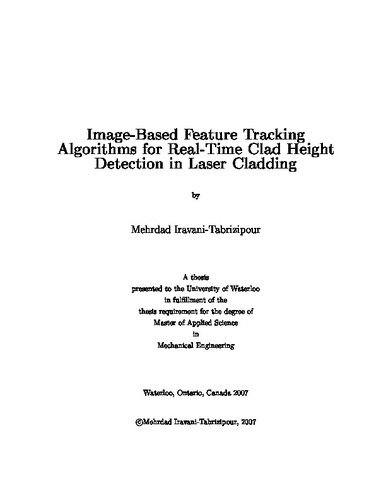| dc.description.abstract | In laser cladding, a material, usually in the form of powder, is deposited on a substrate. Powder particles are intermingled with inert gas and fed by a powder feeder system on
the substrate. Laser is employed to melt the additive material and a small layer of surface of the substrate simultaneously. While the powder is being deposited, the laser melts the powder particles and the melted powder particles join the melt pool on the substrate beneath the laser beam. Generating relative motion between the laser focal point and the substrate will result in moving melt pool on the substrate. This will lead to addition of
a desired material to the substrate with desired thickness and good bonding as well as minimum dilution. In addition, by producing clads beside and on the top of each other a functional component can be built in a layer by layer fashion.
Despite many advantages of laser cladding, it is highly sensitive to internal and external disturbances. This makes a closed-loop control system for laser cladding inevitable.
Utilizing a closed-loop control system in laser cladding makes the system insensitive to external and internal disturbances. Having a closed-loop control system for laser cladding would contribute to substantial improvement in clad quality and cost reduction. Feedback sensor is an essential part in a closed-loop control system. Among different parameters
that can be used as feedback signals in a closed-loop control of laser cladding, melt pool geometry and in particular clad height is of great importance specifically for the purpose of rapid prototyping.
This thesis presents novel algorithms for real-time detection of clad height in laser
cladding. This is accomplished by the following:
Tackling the issues pertinent to image acquisition in the presence of harsh and intensive light is scrutinized. Important parameters of digital cameras related to selection of proper type of CCD cameras in order to overcome the existent harsh condition are presented.
Also, the existent light in laser cladding arisen from different sources is analyzed and
based upon that proper bandpass filters and neutral filters are selected. All these lead to capture relatively sharp and clear images of the melt pool. Capturing good quality pictures potentially would provide valuable information about the process. This information could include, but is not limited to, melt pool geometry (i.e., melt pool height, width, melt pool profile, and wet angle), angle of solidification, melt pool temperature, and melt pool
temperature distribution. Furthermore, the issues regarding path dependency of the melt
pool image are addressed by using a trinocular cameras configuration. By utilizing this, always two cameras monitor the front end of the melt pool regardless of the direction of the clad.
Image analysis of the grabbed images is also discussed. Image thresholding is one of
the most formidable tasks in image processing and this difficulty is intensified due to characteristics of the grabbed images of the melt pool (e.g., surrounding hazy area around the melt pool). Applying hard partitioning thresholding method did not lead to detec-
tion of the melt pool accurately. As a result, fuzzy thresholding by minimizing of the measure of fuzziness is developed and its performance is investigated. The effect of three
important membership functions, triangular, Gaussian, and generalized Bell on the performance of the thresholding method is investigated. Also, Image thresholding by utilizing fuzzy c-means clustering is developed. Applying the developed thresholding methods show promising results. Among the developed thresholding methods, fuzzy thresholding with minimizing the measure of fuzziness with Gaussian membership function is selected for the
implementation in the algorithm.
Finally, Image feature tracking module is presented. The detected borders of the melt
pool images are transformed from image plane to the world plane by using a perspective transformation. Four features of the elliptical features of the projected melt pool borders are selected. These four features along with the angle of tangential path vector with respect to the corresponding right hand side camera's axis are fed into an Elman recurrent
neural network. The proposed algorithms and the trained neural network are utilized in
the process resulting in acceptable detection of the clad height in deposition of straight
clads for a specific direction. It is concluded that the system can detect the clad height with about ±0.15 mm maximum error. | en |

